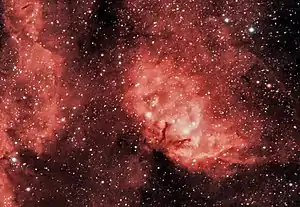Sh2-101
Sharpless 101 (Sh2-101) is a H II region[1] emission nebula located in the constellation Cygnus. It is sometimes also called the Tulip Nebula because it appears to resemble the outline of a tulip when imaged photographically. It was catalogued by astronomer Stewart Sharpless in his 1959 catalog of nebulae. It lies at a distance of about 6,000 light-years (5.7×1016 km; 3.5×1016 mi) from Earth.
| Emission nebula | |
|---|---|
| H II region | |
 Sh2-101 Credit: Chuck Ayoub | |
| Observation data: J2000.0 epoch | |
| Right ascension | 20h 00m 29.37s |
| Declination | 35° 19′ 13.9″ |
| Distance | 6,000 ly (1,800 pc) |
| Apparent magnitude (V) | 9.0 |
| Apparent dimensions (V) | 16' x 9' |
| Constellation | Cygnus |
| Designations | Sharpless 101, Sh2-101, Cygnus Star Cloud |
Sh2-101, at least in the field seen from earth, is in close proximity to microquasar Cygnus X-1, site of one of the first suspected black holes. Cygnus X-1 is the bright star near the bottom right corner of the image presented here.[2]

20200720 sh2-101
See also
References
This article is issued from Wikipedia. The text is licensed under Creative Commons - Attribution - Sharealike. Additional terms may apply for the media files.